Weevils sit in the Curculionidae family. They are small beetles ranging from 0.125 to ¼ inch long. Characteristically, a long and narrow snout protrudes from a hard-shelled body. Chiefly pear-shaped with six legs and antennae, weevils live (and significantly damage) garden plants, crops, and stored food such as grains and cereals. There are an incredible 97,000 weevil species. The majority are classed as rice, granary, or root weevils, but let’s dive in and discover 11 specific types of weevils.
1. Strawberry Root Weevil
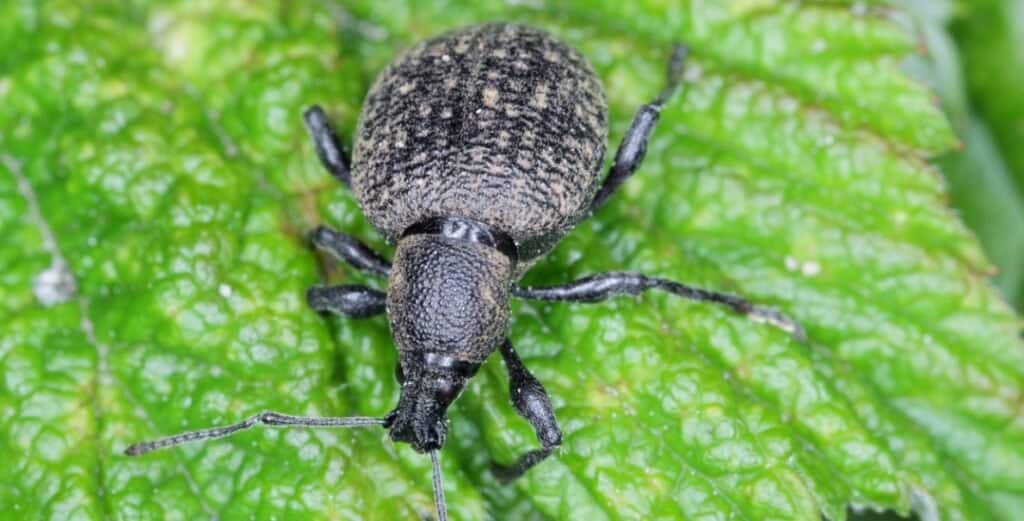
This type of weevil eats strawberry, raspberry, and evergreen plant roots.
©iStock.com/Tomasz Klejdysz
This common U.S. weevil emerges in adult form from June to August. Each dark brown weevil is around 1/4 inch long, and small pits dot its shell. Strawberry root weevils cannot fly, so many folks mistake them for ticks.
These destructive weevils eat strawberry roots as their name suggests, but also evergreens, raspberries, and bramble roots. Dampness attracts these weevils, so they’ll often pop up in the house during summer, looking for water in basins, baths, and sinks. Adults eat foliage, but their larvae are more destructive because they eat plant roots.
2. Boll Weevil
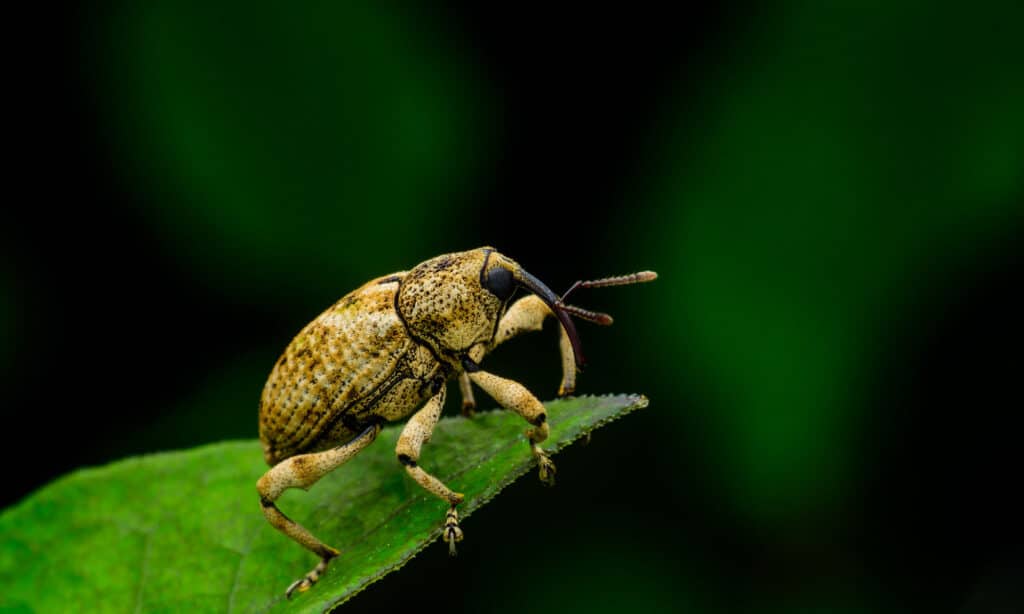
Boll weevils decimated southern state cotton crops in the 1920s.
©Samuel Lam/Shutterstock.com
This is a well-known weevil due to its devastating impact on cotton.
Boll weevils are native to Central Mexico and invaded the United States cotton-producing areas in the 1920s, causing huge problems in the cotton industry, although the first recorded spot was in Texas in 1892. An eradication program started in 1978 helped restore production, but it’s still a serious pest.
A gray boll weevil reaches ¼ inch long, and its even longer snout makes it especially recognizable. This type of weevil can’t fly very far, but adults drift on air currents and airborne leaf litter. Adult female boll weevils lay eggs in cotton plants’ flowers and seed pods (the bolls), and when larvae hatch after a few days, they eat the plant, rendering it unusable.
Boll weevils are eradicated from many southern states, but they still appear in Texas fairly frequently. This is the only weevil immortalised by Elvis Presley in his song Little Sister: “She’s mean, and she’s evil like that old boll weevil”.
3. Large Pine Weevil
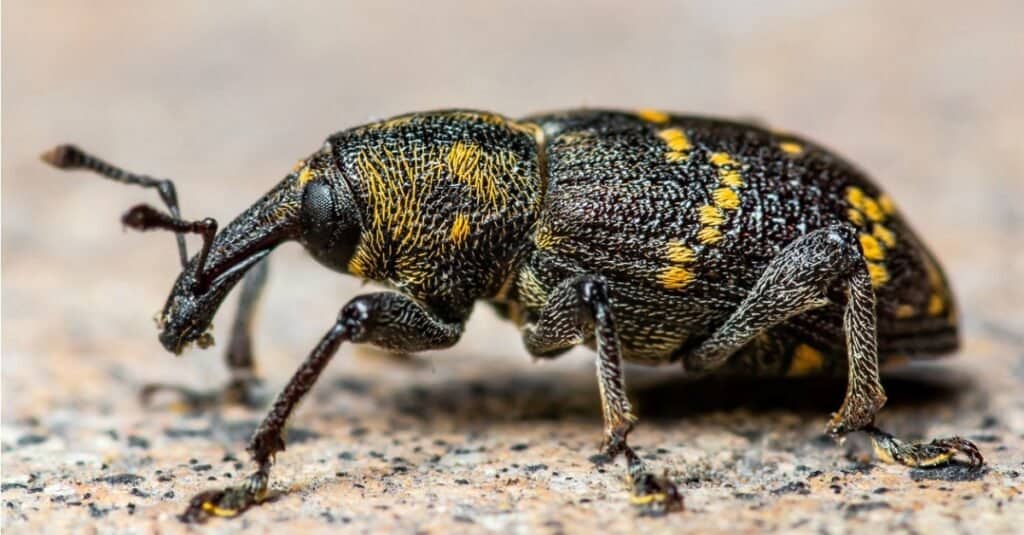
The large pine weevil eats coniferous tree bark, such as Scot’s Pine.
©iStock.com/nechaev-kon
Pine weevils live in young conifer and broadleaf trees such as Scots Pine and Douglas Fir. They’re a serious pest of coniferous commercial plantations in Europe.
These 1.4-inch long dark brown weevils have dark red legs and light brown hairs on their wing cases. Most nocturnal pine weevils feed on living tree bark and prefer young trees. An infestation can destroy entire unprotected plantations of newly stocked young trees.
Cream-colored pine weevil larvae hatch from felled tree stumps and fly to living trees to mate and feed. They tend to breed in spring and again in fall.
4. Nut Weevil
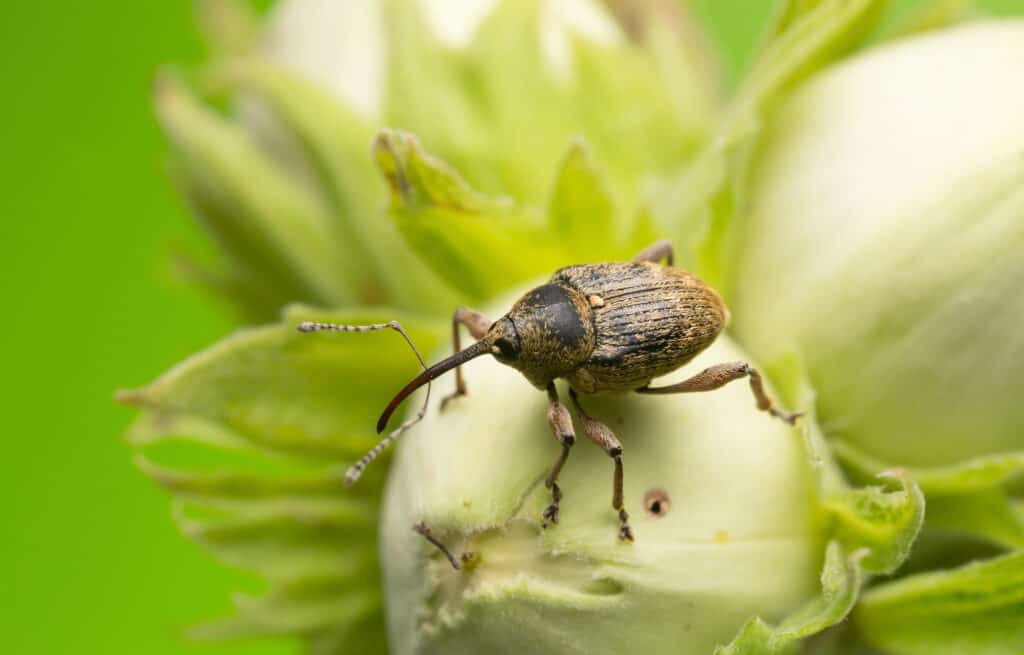
Hazelnuts are a prime target for egg-laying nut weevils.
©iStock.com/Henrik_L
Nut weevil larvae infest hazelnuts in trees in Europe and Asia. This type of weevil is dark brown with black or orange dots and an exceptionally long snout. Measuring less than ¼ inch, this weevil can decimate hazelnut orchards.
They’re most active in spring when adult nut weevils emerge from hibernation in leaf litter to feed on to nut tree flowers and foliage. One egg is laid inside a developing nut. As it grows, the larva eats the nut, then burrows out and falls to the leaf litter. Nut weevil larvae overwinter in the soil, transforming into fully-fledged adults that emerge in spring.
5. Rice Weevil
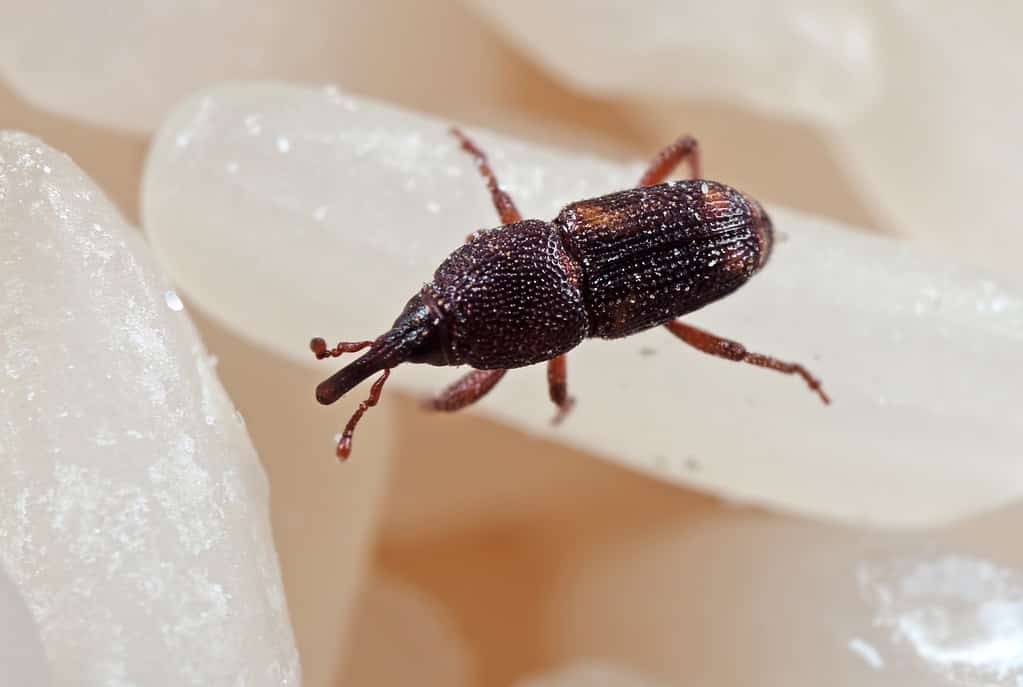
A rice weevil is also known as a maize weevil, but they infest corn, oats, wheat, and pasta too.
©Cherdchai Chaivimol/Shutterstock.com
This type of weevil is brown or black with a cross of four orangey-red spots on its wing case. It can fly, which increases its ability to wreck stored grain. It will also live in oats, wheat, pasta, corn, and birdseed.
Rice weevils, also called maize weevils in the U.S., attack stored produce in commercial and domestic households. Just 1/10-an-inch long, tiny female rice weevils chew a hole in a grain of rice and lay an egg. The larva eats the rice grain’s kernel, and an adult emerges just 28 days later.
6. Wheat Weevil
The wheat weevil, also called the granary weevil, is a common pest in the United States. It attacks cereal grains in the field and storage. At first glance, a wheat weevil resembles a rice weevil, however even though they both lay eggs inside a grain, wheat weevils are completely brown, shiny, and chiefly larger at 1/8th an inch long.
A wheat weevil larva develops entirely with the cereal grain, only emerging once it’s fully grown. This type of weevil plays dead if threatened or disturbed! It does this by drawing up its legs and lying totally still.
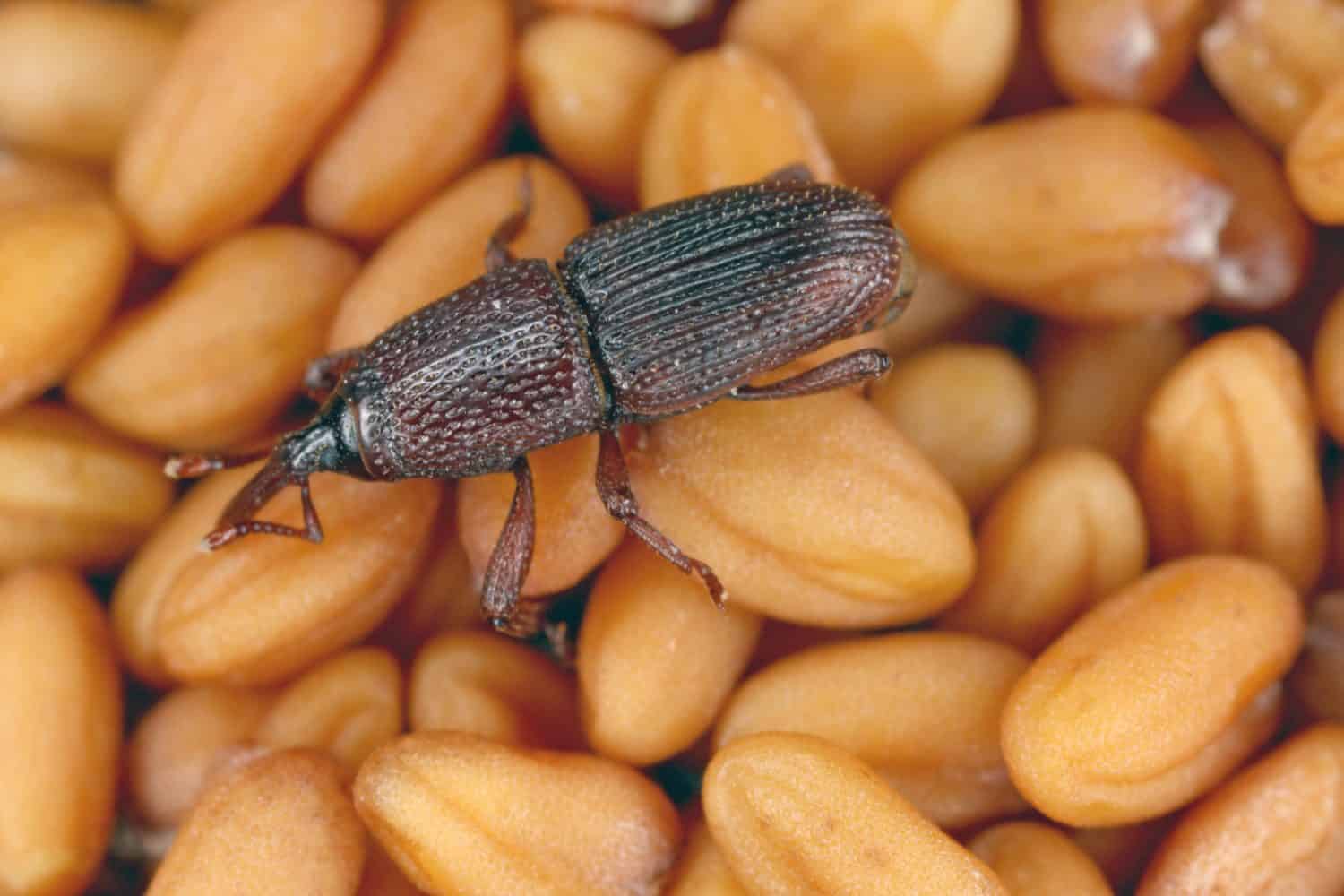
If it’s disturbed, a wheat weevil plays dead to confuse predators.
©Tomasz Klejdysz/Shutterstock.com
7. Cabbage Stem Weevil
Cabbage stem weevils measure a touch under 1/8th inch. They have weevil-typical long snouts and red-brown legs on a dark gray-yellow-white speckled body. Most noticeable is a single white back spot. They resemble cabbage seed weevils; however, the seed weevil does not have a white spot.
This weevil type infests brassicas like cabbages. Adults hibernate, overwinter in leaf litter, and emerge in April to May to mate and lay eggs beneath leaf surfaces. A hatched larva then burrows into brassica stems and eats until they drop to the ground to pupate.
Cabbages infested with cabbage stem weevil will be peppered with numerous tiny stem holes and nibbled leaf margins.
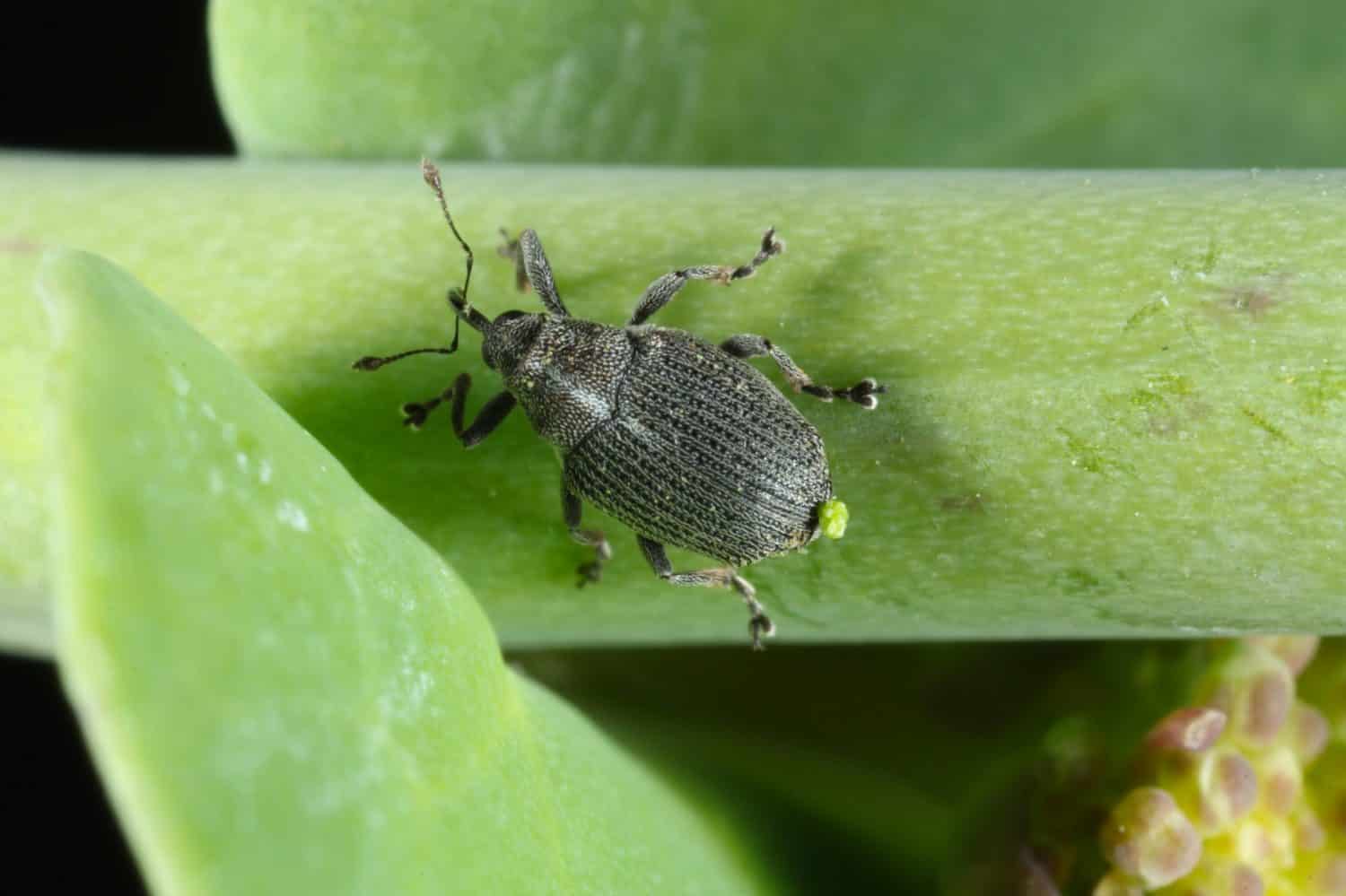
This weevil digs into cabbage or oil seed rape plants to lay its eggs.
©Tomasz Klejdysz/Shutterstock.com
8. Lilac Root Weevil
Something nibbling your lilac bushes? Perhaps the foliage is yellowing despite high-quality feed? It could be dreaded lilac root weevils munching on your lovely plant. Not content with destroying lilac, this type of weevil also eats peonies and euonymus.
Just 0.25 of an inch long, with a shiny brown body and a long typical weevil snout, adult lilac root weevils eat the foliage and leave U-shaped margins, but their larvae feed on the root system. They love moisture, so in summer, you might find they migrate into your home.

A distinctive nibbled margin emerges on lilac foliage if the plant is infested with lilac root weevils.
©Kazakov Maksim/Shutterstock.com
9. Vine Weevil
Vine weevil is a common sight in the yard, especially ornamental plants like lilies. This type of weevil is drawn to container plants, but it will infest ground-rooting plants, too.
Flightless adult vine weevils eat foliage. They’re dark brown with yellow wing case markings and reach around ¼ an inch long at most. You are more likely to spot leaf margin damage before spotting an actual vine weevil. Larvae live and feed on roots below the soil surface. Grubs have brown heads and creamy white bodies.
Common vine weevils don’t hurt humans, but the larvae damage ornamental plants. Control an infestation by emptying a container and replacing the soil with fresh. Pick off adult weevils by shaking the plant over an open umbrella.
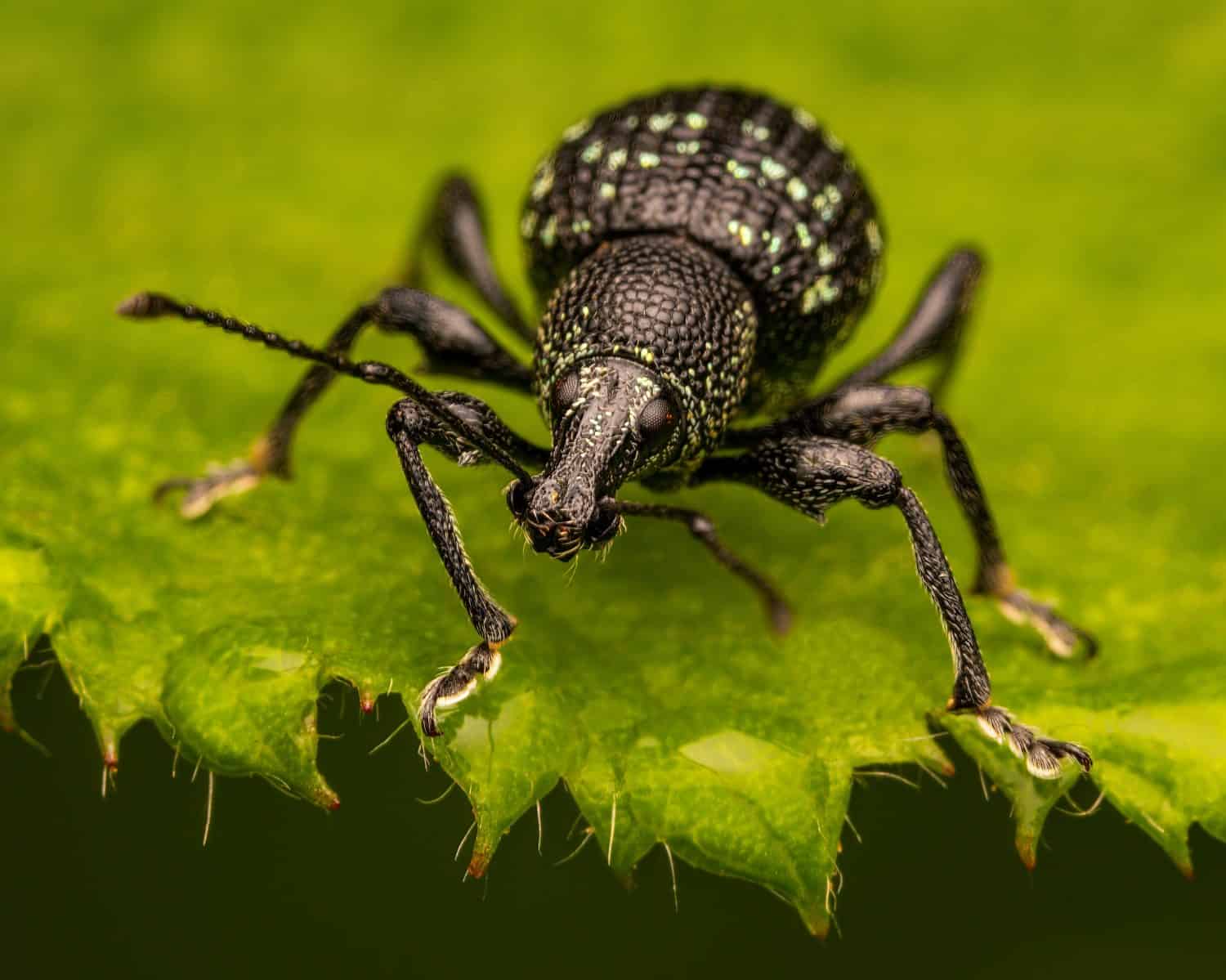
If your ornamental plants fail to flourish, consider the vine weevil.
©Eduard Andrica/Shutterstock.com
10. Sweet Potato Weevil
This type of weevil is considered the most damaging sweet potato pest in the world. Despite its devastating infestation, this weevil is very pretty. It looks ant-like with a long, thin abdomen, legs in reddish brown, and a metallic blue abdomen. Its distinctive weevil snout is elongated, and long antennae emerge halfway down.
A sweet potato weevil reaches ¼ an inch long at most. Adults fly very short distances to feed on foliage, mate, and lay eggs in sweet potato tubers. An egg hatches after a few days, and the larva eats sweet potato flesh before burrowing out as an adult. The interior of a weevil-infested sweet potato is a maze of tiny tunnels filled with poop.
The first sign of sweet potato weevils is yellowing foliage as they destroy the plant from its roots upwards.

A maze of tiny tunnels is created by sweet potato weevil grubs.
©Jojo dexter/Shutterstock.com
11. Giraffe Weevil
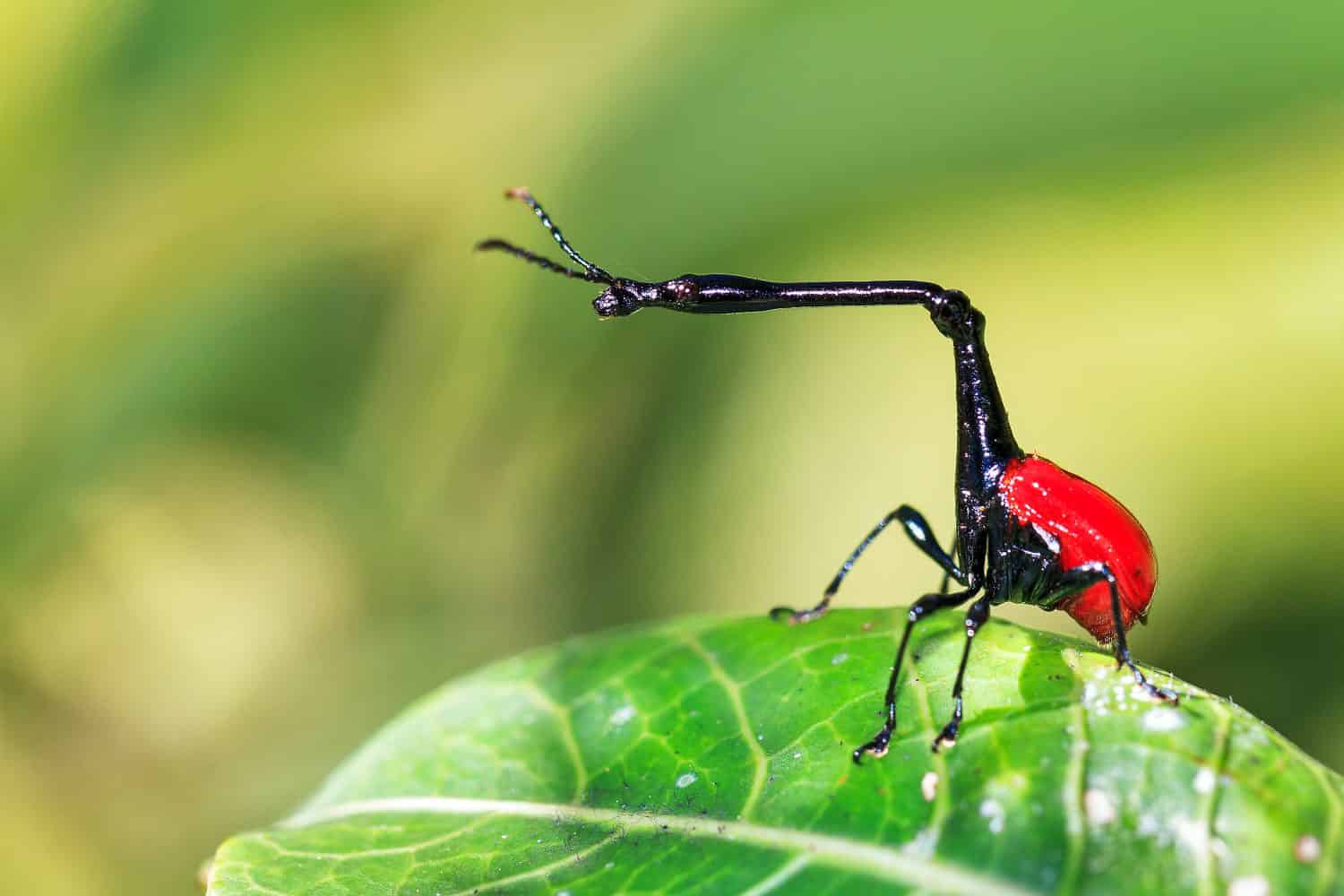
Giraffe weevils have extra long necks. They’re native to Madagascar.
©Dennis van de Water/Shutterstock.com
No surprise that the giraffe weevil resembles a giraffe. This type of weevil is endemic to Madagascar and named for a super-long snout that’s longer than its body.
It’s a pretty weevil with a deep red abdomen that covers its wings and black legs and a snout that all reach just under an inch in length. That super snout measures at least two-thirds of the stretch! Males have necks two to three times longer than females, but experts aren’t sure why yet.
In tropical forests, giraffe weevils live in the giraffe beetle tree (Dichaetanthera arborea). Females lay an egg inside a rolled-up leaf, then cut the leaf so it falls to the floor. Larvae hatch out and eat leaf litter before burrowing into the soil to transform into a full adult.
Incredibly, this type of weevil was only discovered in 2008!
The photo featured at the top of this post is © Protasov AN/Shutterstock.com
Thank you for reading! Have some feedback for us? Contact the AZ Animals editorial team.







